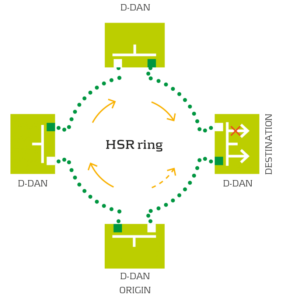- Home
- Technical Products
Enterprise Cloud IT Solutions
Test Measurement
Industrial Measurement
- Solutions
Enterprise Cloud IT Solutions
Test Measurement
- Latest Articles
- About Us
 EN
EN
DHSR
Confirmation of HSR switch IP kernel
High-availability Seamless Redundancy (HSR, IEC 62439-3-Clause 5) provides redundancy by sending packets bi-directionally over a ring network. In the event of an interruption within the ring, the HSR-enabled target node will always receive frames on the other port.
The IEC 62439-3-Clause 5 standard defines the priority of traffic received from the ring. Therefore, it is feasible to calculate the worst case scenario for delivering messages within the HSR ring. This behavior allows the use of standard HSR in certain real-time environments.
However, if timing and bandwidth usage constraints are stringent, it is necessary to add timing planes to the HSR node in order to deliver the data traffic in a scheduled manner.The IEEE 1588 protocol is the driving force behind the construction of deterministic HSR solutions, which are focused on critical industries such as electrical or defense, and which favor robust hardware-based solutions that are simpler than general-purpose TSN solutions. The solution focuses on critical industries such as electrical or defense.
The Definitive HSR (DHSR) IP core is a proprietary hardware-based solution optimized for reconfigurable devices and can be upgraded if the IEC publishes the final interoperability standard for Definitive High Availability Seamless Redundancy.

Key Features
- Precise frame sending with certainty in HSR
- Cyclic time segment multiplexing based on precise clock synchronization
- Routine Features Listed in the HSR/PRP Switch IP Core
Keeping up with the times and innovating - Explore more potentials of TSN with Hongke
Time Sensitive Networking (TSN) is a new generation of network technology based on the evolution of the standard Ethernet architecture. It takes traditional Ethernet as the network foundation and provides a data link layer protocol specification for deterministic data transmission capability through mechanisms such as clock synchronization, data scheduling, and network configuration. Compared with traditional Ethernet, TSN can provide microsecond-level deterministic services, reduce the complexity of the entire communication network, and realize the convergence of information technology (IT) and operation technology (OT). With its precise clock synchronization, deterministic traffic scheduling, and intelligent and open operation and maintenance management framework, TSN can ensure the high-quality transmission of multiple business traffic in a common network, and it has both performance and cost advantages, and it is the development trend of the future network. This is the future trend of network development.
Currently, TSN technology has a high level of discussion in the automotive, industrial, rail transportation, and aerospace fields. As a non-vendor-bound real-time communication protocol, we believe that TSN technology has a good application prospect.
Welcome to contact us to explore and learn the integration of TSN technology with various industries, and actively promote more applications on the ground to jointly build a new world of intelligent interconnection.

